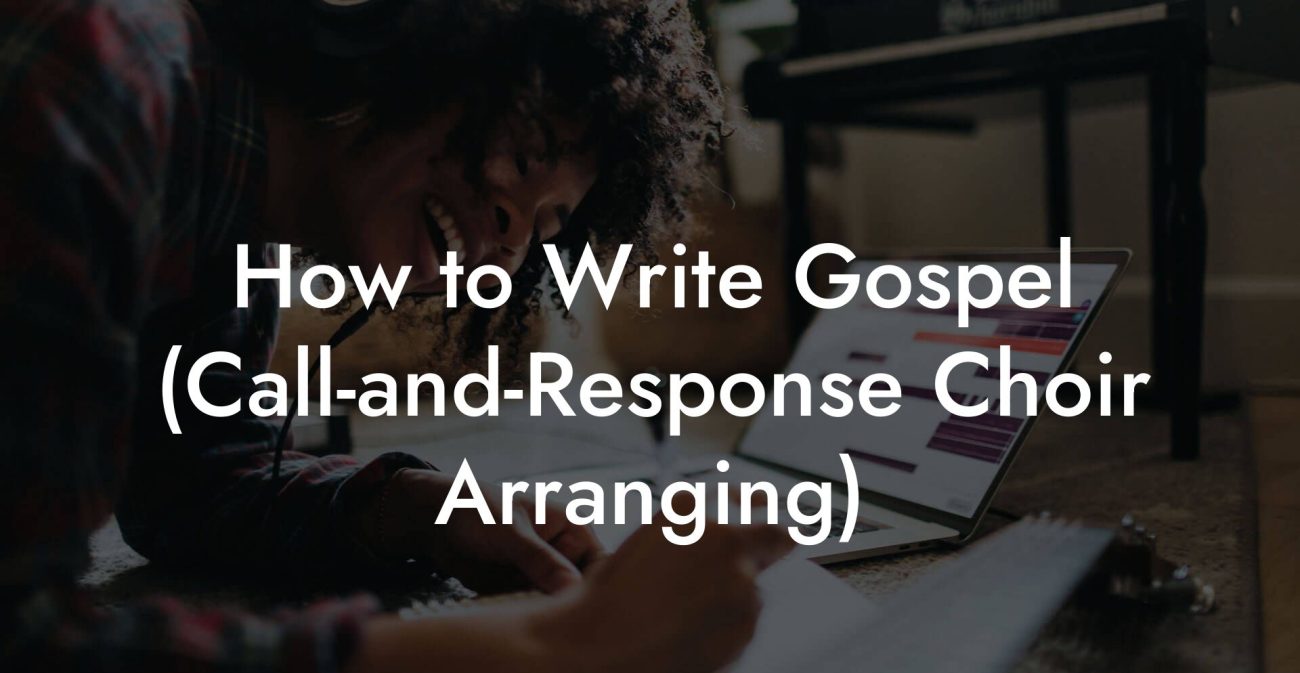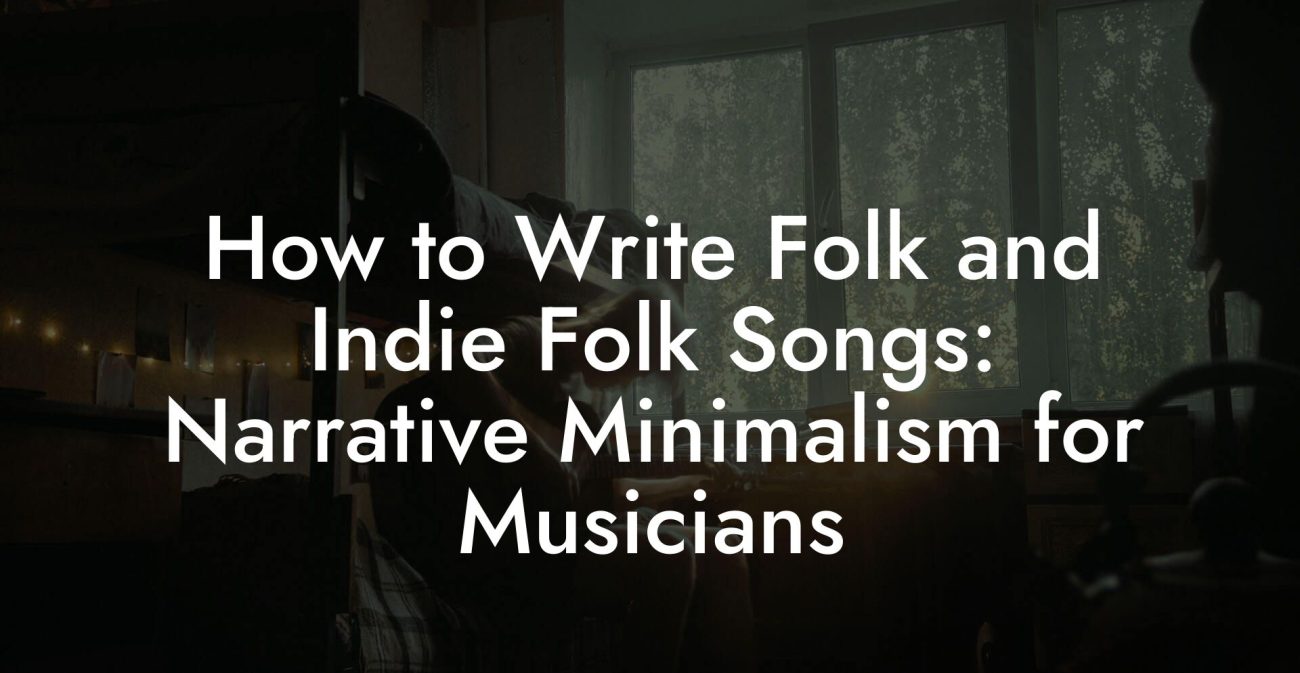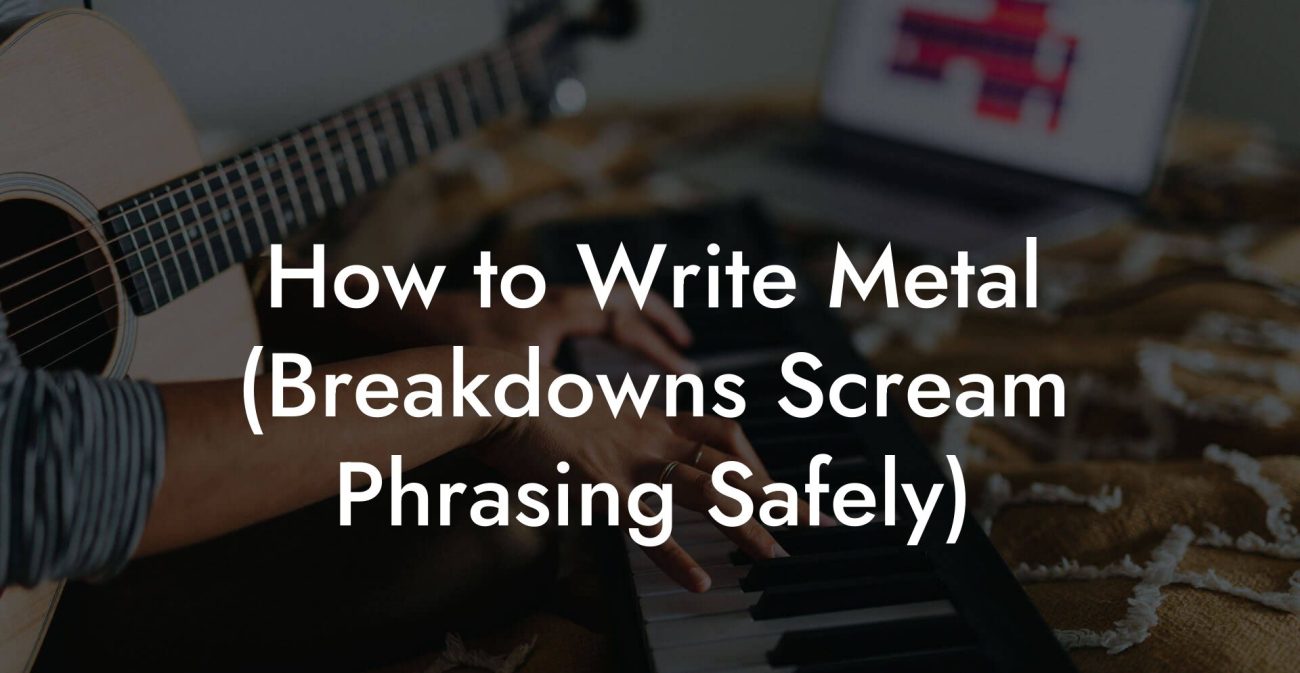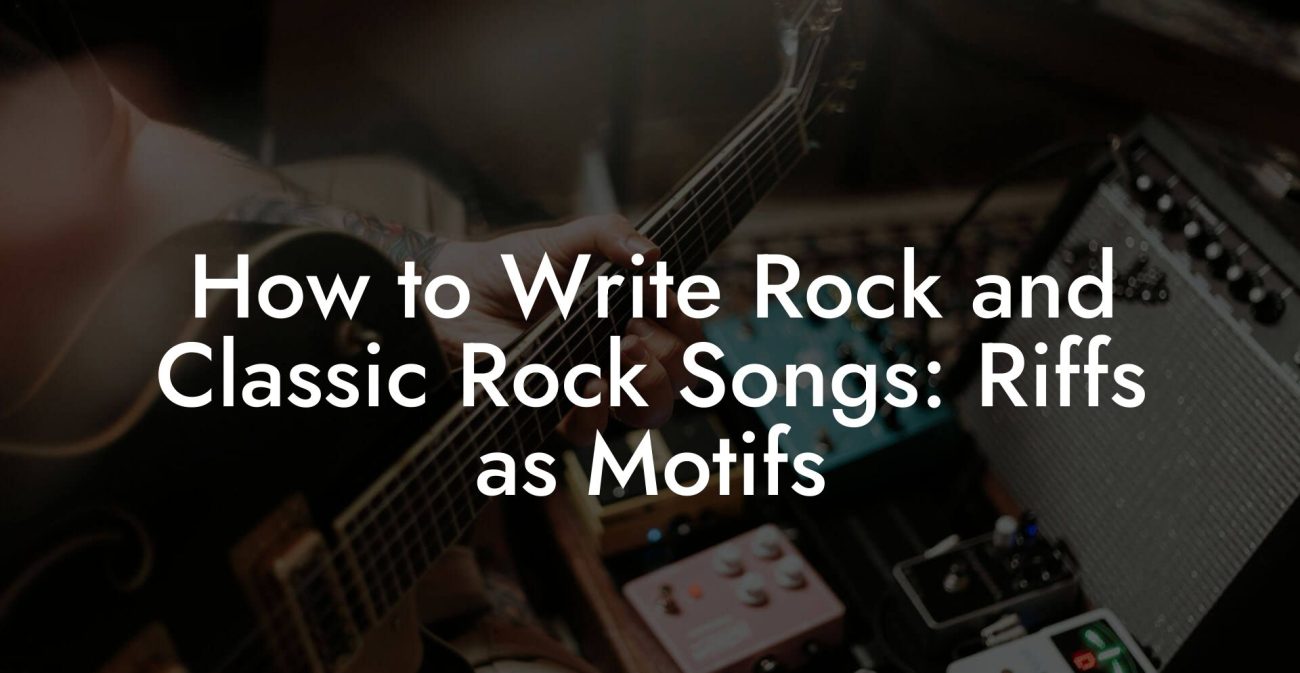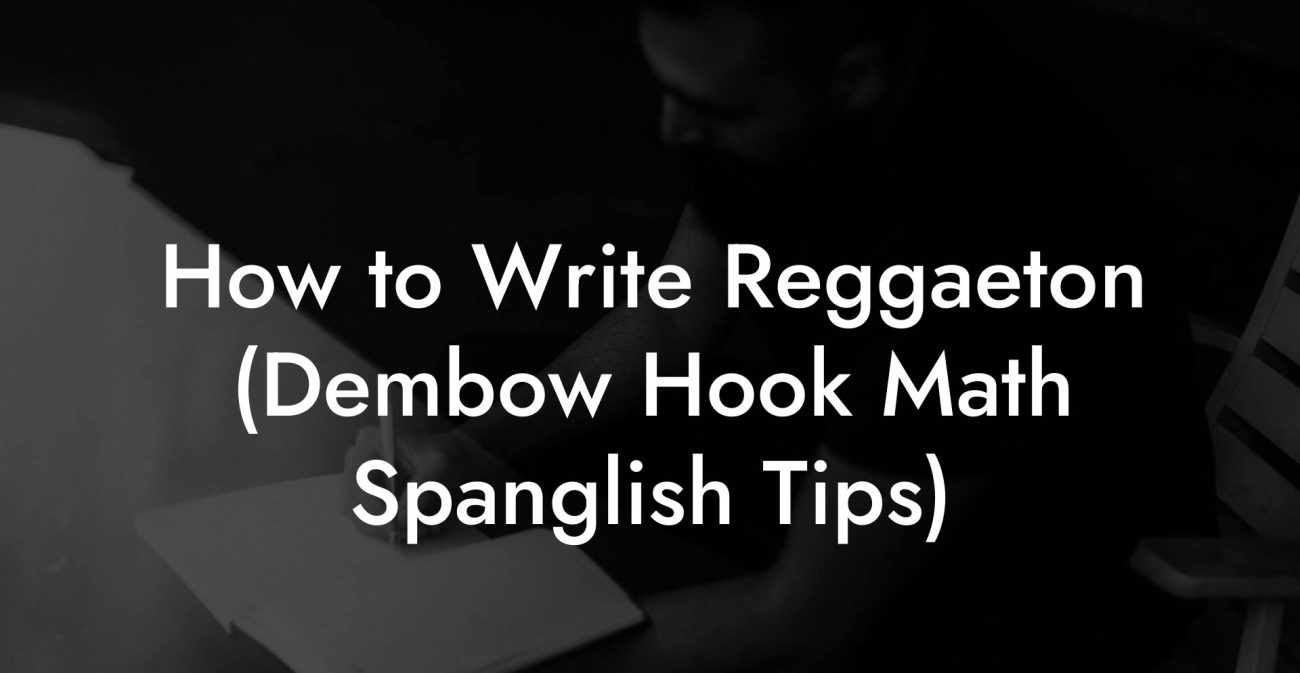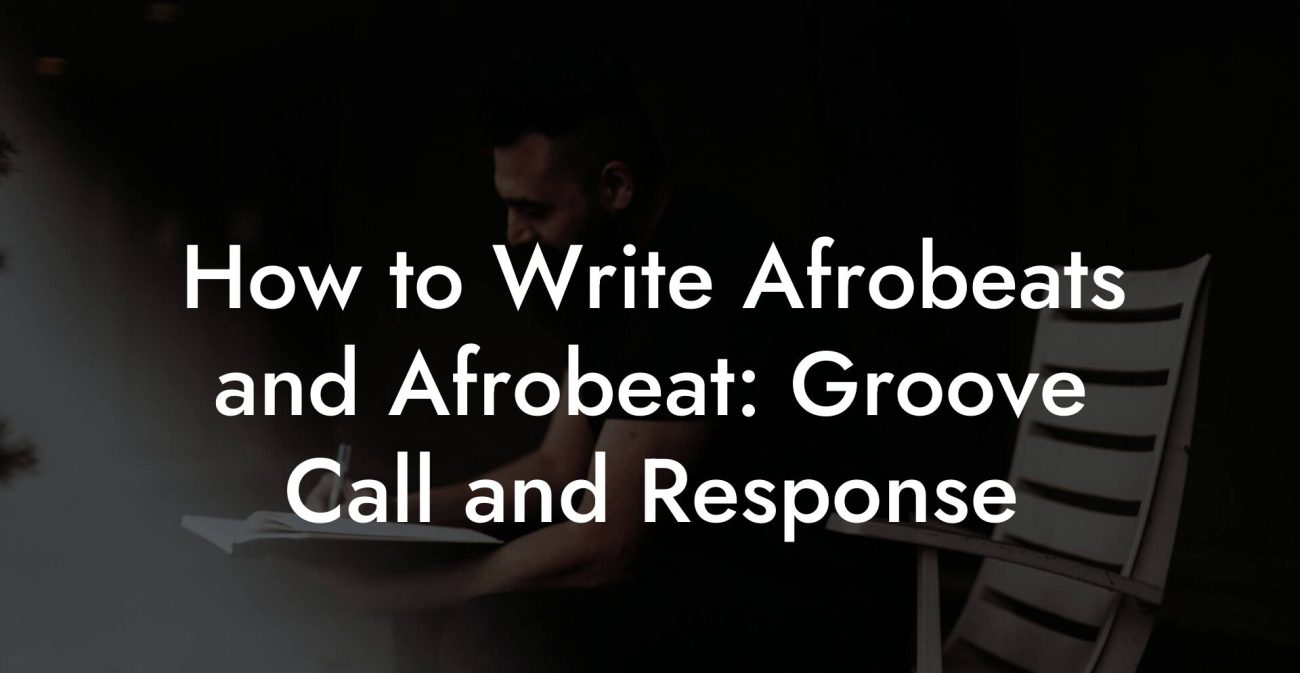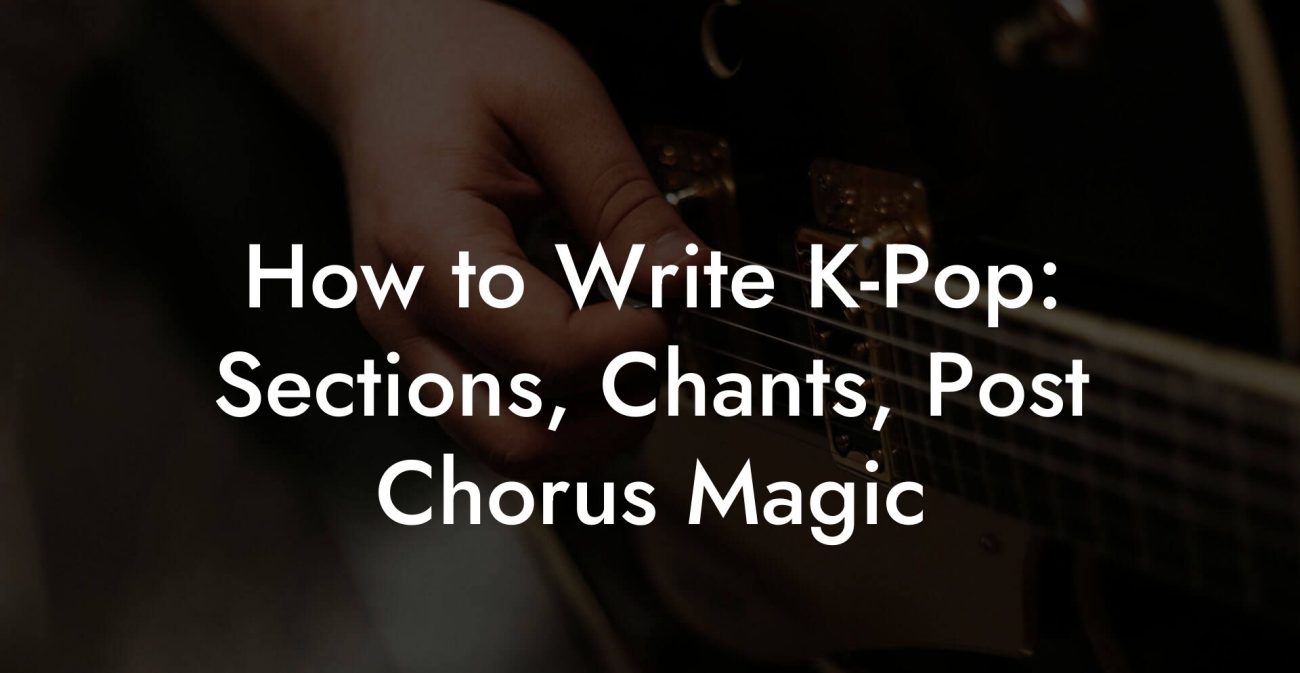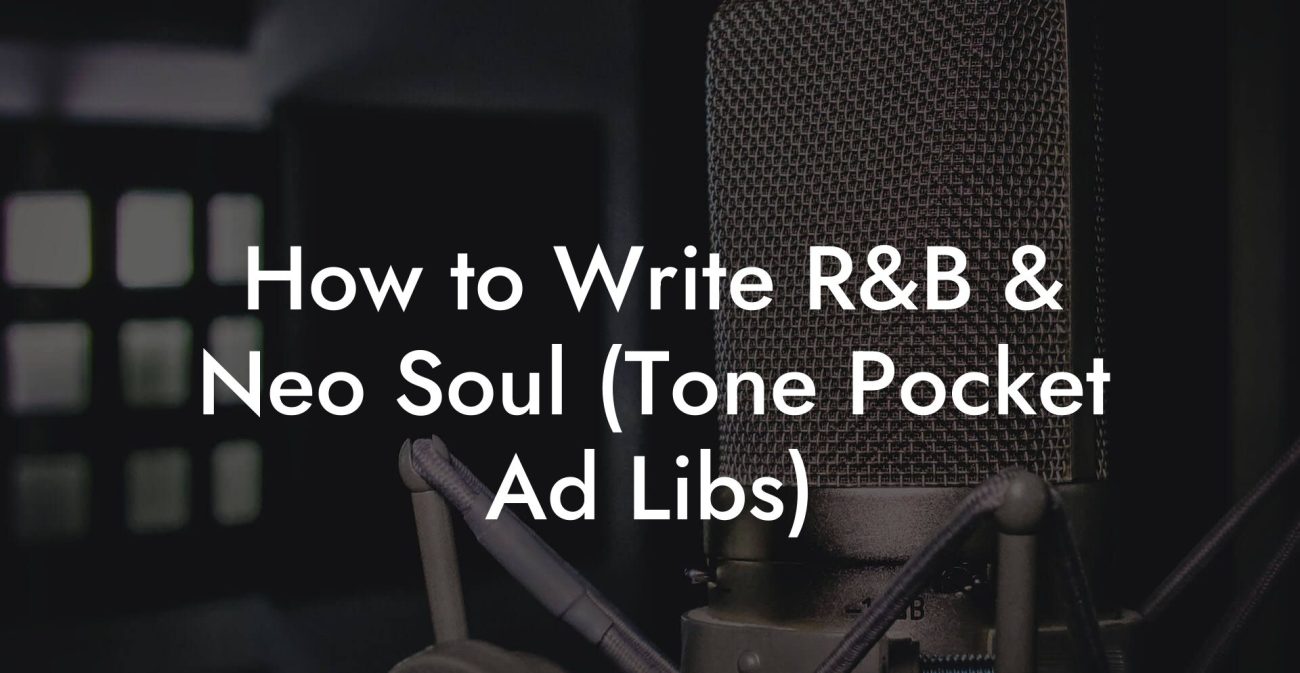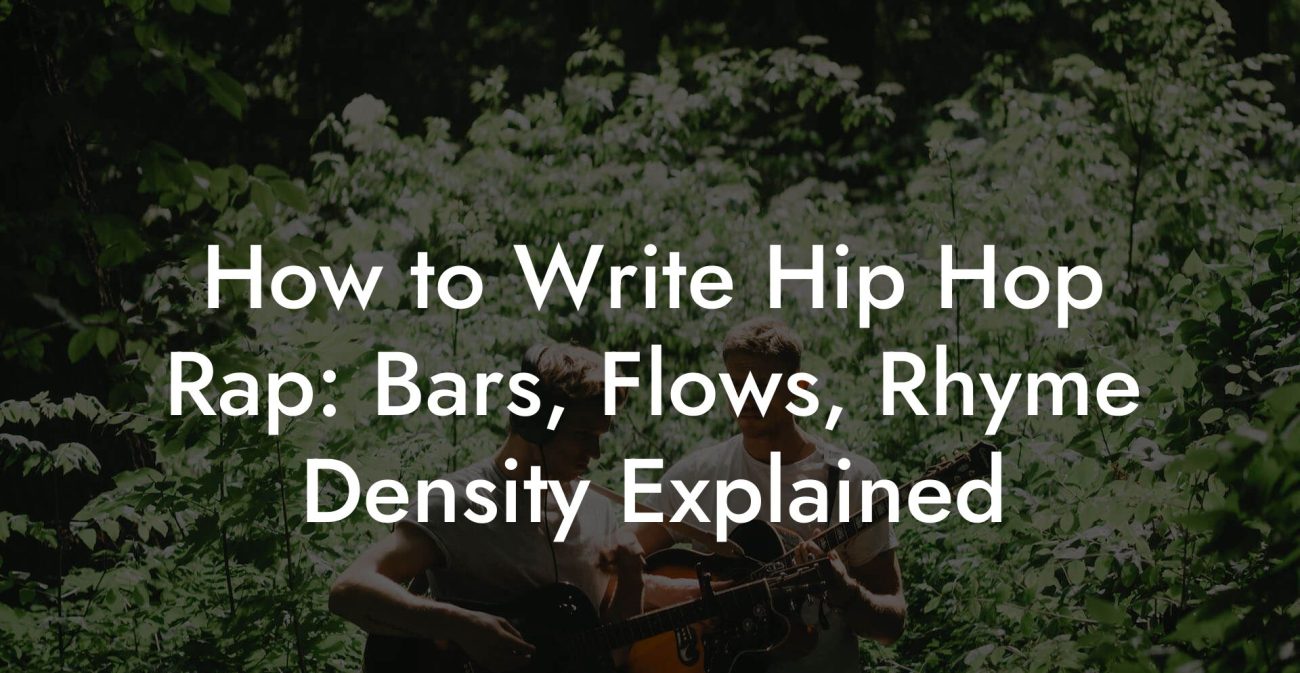Songwriting Advice
How to Write Reggae (Off Beat Placement Lyric Themes)
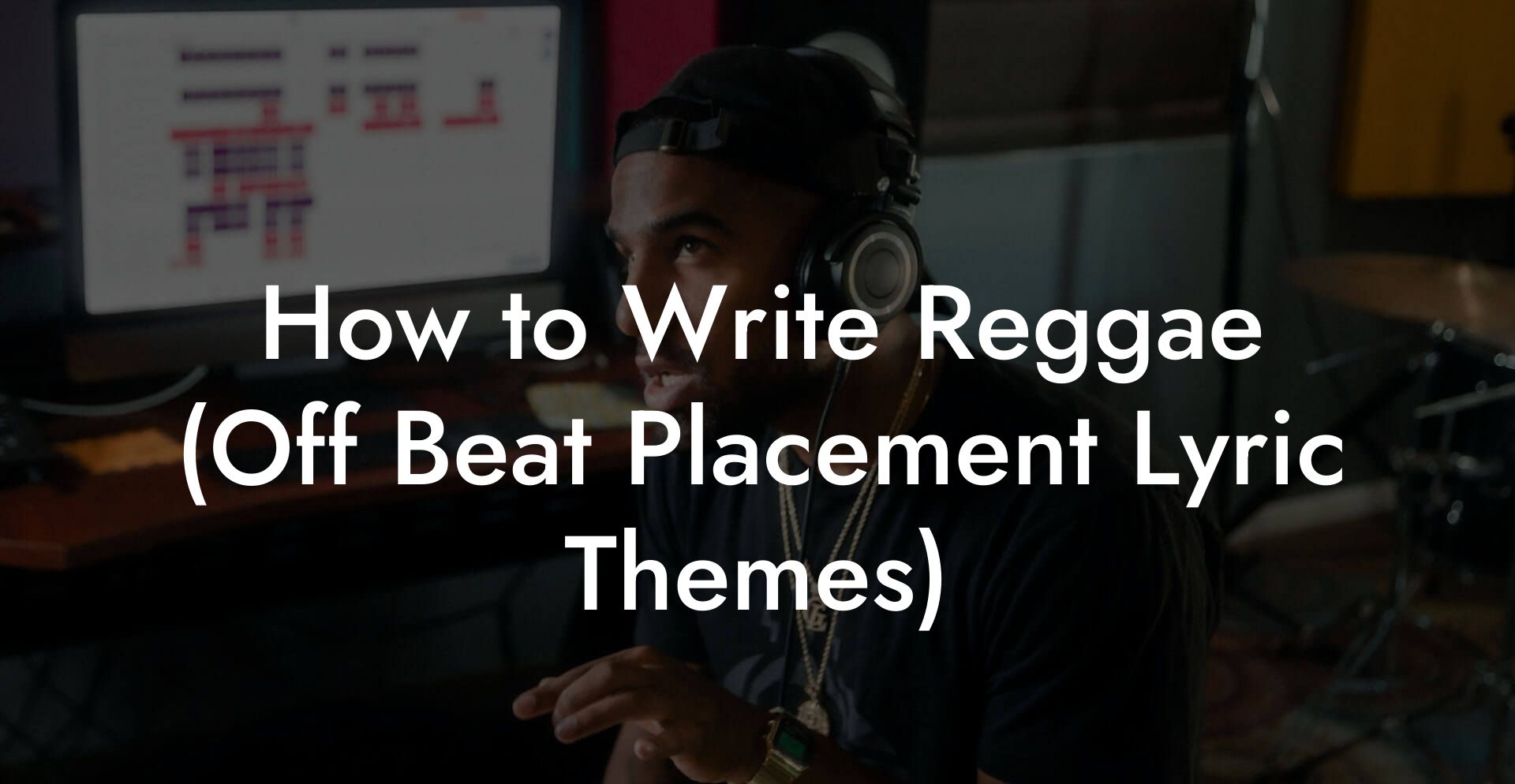
You want a song that makes people sway their shoulders and forget the office email thread of doom. You want a groove that sits behind your chest like a warm hoodie on a rainy day. Reggae is both invitation and statement. It asks the listener to move easy and to think deep. This guide gives you practical skills to write reggae that feels authentic while staying fresh for millennial and Gen Z ears.
Quick Interruption: Ever wondered how huge artists end up fighting for their own songs? The answer is in the fine print. Learn the lines that protect you. Own your masters. Keep royalties. Keep playing shows without moving back in with Mom. Find out more →
Quick Links to Useful Sections
- Reggae in a Sentence
- Core Rhythmic Concepts
- 4 4 Time is the basic frame
- The off beat placement
- One drop and the pocket
- Skank and bubble
- Bass and Drum Relationship
- Bass writing rules of thumb
- Drum feel tips
- Common Reggae Rhythms and Substyles
- Roots reggae
- Rockers
- Steppers
- Dancehall and toasting
- How Melody Works in Reggae
- Melodic contour tips
- Lyric Themes That Work in Reggae
- Love and relationships with honesty
- Everyday resilience
- Social commentary and protest
- Spiritual approaches
- Party and celebration
- Writing Lyrics to Fit the Off Beat
- Prosody in reggae
- Line length and pockets of silence
- Melody and Rhythm Exercises
- Vowel camp
- Timing shift drill
- Use the skank as punctuation
- Practical Songwriting Workflow
- Hands On Writing Prompts
- Lyric Examples You Can Model
- Common Mistakes and Fixes
- Overwriting the chorus
- Melody fighting the skank
- Lyrics that are either too abstract or cliché
- Production Tips for Authentic Reggae Sound
- Get the bass right
- Skank tone and verb
- Space and echo
- Keep the drums human
- Arrangement Ideas
- Collaboration Tips
- Modernizing Reggae Without Losing Soul
- Song Finishing Checklist
- Examples of Full Song Starters
- Starter One
- Starter Two
- Starter Three
- How to Practice Daily
- Frequently Asked Questions
This is for writers who know music can be playful and political at the same time. We will cover the rhythmic fundamentals including off beat placement, bass and drum roles, common reggae rhythms, melodic and lyrical strategies, thematic choices that actually matter, songwriting workflows, and production ideas that keep your track sounding like a record people will replay on a loop. Expect real life examples, tongue in cheek lines you can steal from your own life, and exercises you can do in your bedroom or the studio van.
Reggae in a Sentence
Reggae is a rhythmic language built from space and weight. The drums and bass carry the pocket. The guitar or keys play on the off beat. Vocals float above with melody and message. Many reggae songs are calm in tempo but heavy in intention. Think smoke filled porch not stadium stomp. You do not need to imitate Jamaica to write reggae. You need to honor the relationships between rhythm and feel while bringing your own truth to the lyric.
Core Rhythmic Concepts
Understanding rhythm in reggae is like learning to breathe with the band. Get these basics under your skin and everything else becomes decoration.
4 4 Time is the basic frame
Most reggae is in common time which is four beats per bar. Count it as one two three four. The magic is in where the music breathes not in changing time signatures. Keep the meter simple and focus on placement of hits and silence.
The off beat placement
Reggae is famous for having guitar or keyboard chops on the off beat. If you count one two three four with ands like one and two and three and four and the chord stabs land on the ands the groove opens up. Write off beat instead of on beat. The spacing makes the bass and drums feel heavier because they are carrying the down. So when you write melody and lyrics you must leave space for those off beat hits to breathe.
Real life scenario
- Imagine you are walking with a light step. The world drops weight on the even steps. Your voice is the story you tell while you carry the weight. Keep the voice conversational and let the instrument make the sway.
One drop and the pocket
The one drop is a reggae drum pattern where the snare or cross stick lands on beat three and the kick is often light or sits with the snare. This creates a laid back feeling. The pocket refers to the precise timing and small delays in the drum or bass that make the rhythm feel human and locked in. Small timing shifts of 10 to 30 milliseconds can turn a robotic groove into a smokey groove.
Skank and bubble
Skank is the short guitar or piano hit on the off beat. Bubble is a nickname for the light rhythmic keyboard or guitar pattern that moves around the bassline. When writing, sketch the skank first with short chords and then decide where the melody will talk so it does not compete with the skank slices.
Bass and Drum Relationship
In reggae the bass is not a background instrument. It is the spine. The bass often plays simple patterns that lock with the kick drum but it also has space to move melodically. Write bass lines that breathe between the skank hits. The drums should accent the genre mood. A one drop with a heavy bass note can feel more powerful than a complex drum fill.
Bass writing rules of thumb
- Keep the low end simple and rhythmic. Think short phrases repeated.
- Use rests as musical tools. Silence in the bass says as much as notes.
- Anchor sections with a tiny variation in the last bar of an eight bar phrase. That change is what the ear remembers.
Drum feel tips
- Emphasize the third beat in one drop grooves.
- Use ghost notes on the snare or cross stick to add texture without attacking the vocal space.
- Keep high hats loose. Small swing and human timing will sell the vibe.
Common Reggae Rhythms and Substyles
Reggae has evolved into many flavors. Knowing a few templates will speed up your writing.
Roots reggae
Rooted in social commentary and spirituality. Medium tempo, deep bass, and plenty of space. Lyrics often discuss justice, faith, or collective struggle. Think message first then groove.
Rockers
More mid tempo and driving. The drums and bass are more active. Rockers often bridge the energy between roots and modern reggae. These tracks work well for sing along choruses and slightly brighter production choices.
Steppers
Steppers use a steady four on the floor bass drum with melodic bass movement above. They feel more urgent and are good for songs that need forward momentum while staying in reggae language.
Dancehall and toasting
Dancehall is the modern offshoot that emphasizes rhythm and vocal rhythm more than band interplay. Toasting is a vocal style that predates rap where DJs speak rhythmically over the riddim. If you do modern reggae with dancehall elements know that lyric phrasing will become more percussive.
How Melody Works in Reggae
Reggae vocals often feel conversational. Melody will sit in the gaps left by skank and bass. That means melody often breathes and uses short phrases that repeat. For hooks you can stretch notes to create an anchor. Keep melodic leaps tasteful. The genre rewards repetition and small variations.
Melodic contour tips
- Start with short motifs that repeat. Repeat with small variation.
- Leave space after important words for the skank or bass to speak.
- Place the biggest vowel on the longest note for singability.
Lyric Themes That Work in Reggae
Reggae is known for certain lyrical directions but you can add modern twists. Themes are not rules. They are invitations to connect with listeners who come for the groove and stay for the message.
Love and relationships with honesty
Reggae love songs are often intimate and tactile. They use domestic details and small motion images. Avoid romance clichés unless you have a fresh line to justify them.
Example lines
- Your coffee cup still has my lipstick at the rim and I pretend it is a compass.
- I fold your shirt like a promise and put it in the drawer where time forgets.
Everyday resilience
Songs about small victories are huge in reggae. Not always doomsday protests. Celebrate survival and stubborn joy. This resonates with younger listeners who want authenticity not sermonizing.
Real life scenario
- A barista who makes rent after three shift swaps. A kid who learns how to fix a bike chain. Each small victory can be a chorus anchor.
Social commentary and protest
Political reggae is powerful when it focuses on tangible injustice and offers a human face. Avoid abstract slogans. Name a place, a daily inconvenience or a system detail and then bring the human reaction.
Example lines
- The lights go off at six and the bills keep coming in my name.
- They put a fence around the park and my kid learns to climb city rules like ropes.
Spiritual approaches
Spiritual reggae can be literal or metaphorical. Use ritual images. Talk about small daily acts that feel like prayer. This keeps spirituality grounded and relatable.
Party and celebration
Not all reggae is heavy. Many songs celebrate dance and release. Party lyrics in reggae often fuse community images with sensory detail like food and lights and laughter.
Writing Lyrics to Fit the Off Beat
Here is where many songwriters trip. You have an instrument that speaks on the ands and a vocal line that wants to tell a story. The trick is to arrange words so the key syllables land on the musical strong beats while the smaller words ride between the skank hits.
Prosody in reggae
Prosody means that the stress in the words should match the emphasis in the music. For reggae the musical weight often sits on beat three and on the off beat skank. Speak your lines out loud and mark the natural stresses. Then map those stresses to the beat grid. Move words, not syllables, to fit the groove.
Practical exercise
- Clap a simple one drop pattern with bass on one and three and snare emphasis on three. Count one and two and three and four and. Play a skank on each and.
- Say your chorus out loud as if you are texting a friend. Mark the words you naturally stress.
- Place the stressed words on beats one and three. Place unimportant words on the ands so the skank does not interfere.
Line length and pockets of silence
Short lines work best in reggae. A chorus of four to six words that repeats with a small variation will hit harder than a lyric paragraph. Use silence. A full beat of rest after a line can make the next phrase hit like a revelation.
Example chorus idea
Walk slow move steady breathe easy
Repeat the line with a single twist on the last repeat and let an instrumental fill take a beat of rest before the hook returns.
Melody and Rhythm Exercises
These drills will help you write melodies that sit with the groove.
Vowel camp
Sing on single vowels over a bass and skank pattern. Use ah oh and oo to find comfortable high notes. Mark moments you would want to repeat.
Timing shift drill
- Write a simple four word chorus.
- Sang it starting on beat one. Record.
- Sang it starting on the and of one. Record.
- Compare which version breathes with the skank better and why.
Often the version that starts on the and of one will let the skank land under the vocal and keep the phrase clear. That is the off beat relationship in practice.
Use the skank as punctuation
Think of the skank as a punctuation mark like a comma or period. Let your vocal line finish its phrase and then allow the skank to punctuate. Do not try to sing through the skank. Instead let the skank answer the vocal line.
Practical Songwriting Workflow
Here is a stealable workflow from idea to demo that keeps reggae groove intact.
- Make a two bar drum and bass loop. Keep the one drop or rockers pattern simple. Record a skank on the ands. This is your riddim bed.
- Vowel pass. Sing nonsense over the loop and find the melodic gesture you like. Record a few takes. Mark the best motif.
- Write a chorus that uses short lines and repeats a core phrase. Keep the syllable count low. Place the most important word on a long note.
- Write verse lines that are images and actions. Use time crumbs and place crumbs. Keep language conversational.
- Pre chorus optional. Use it to shift energy slightly without changing the feel. A pre chorus can be a two line lift that hints at the chorus word without saying it.
- Practice the vocal with the skank and adjust timing. Move words so stressed syllables match strong beats.
- Record a rough demo and listen on small speakers and on a phone. Reggae is about groove so check it on low fidelity as well.
Hands On Writing Prompts
Use these prompts to generate lines that feel rooted.
- Write a verse about one small injustice in your neighborhood. Describe the object that proves it.
- Write a chorus that repeats one line with a single twist on the third repeat.
- Write a chorus that has four words. Then write three versions that change only one word each time.
- Write a verse that includes a time clock detail such as six thirty or noon. Use that as the emotional anchor.
Lyric Examples You Can Model
Below are short before and after examples to show the rewrite process.
Before: I am tired of the city and all the noise.
After: The streetlight blinks my rent and I count coins like small suns.
Before: We will not take it anymore.
After: They put gates on the park and the kids jump the fence with their sneakers full of songs.
Before: I miss you so much.
After: Your jacket smells like last week and I hug it while the kettle cools.
Common Mistakes and Fixes
Reggae writing commonly trips on a few predictable errors. Fixes are easy and practical.
Overwriting the chorus
Problem
Choruses with too many words destroy the groove.
Fix
- Trim the chorus to one short repeating line. Let instruments fill meaning. Think mantra not essay.
Melody fighting the skank
Problem
Vocal lines that land on the same syllable as the skank will sound crowded.
Fix
- Shift the phrase by a beat or move a word to land on the ands. Use short rests between lines.
Lyrics that are either too abstract or cliché
Problem
Abstract slogans or tired metaphors do not connect.
Fix
- Replace any abstract word with an object, action or a time. Be specific and small. Specific images feel universal.
Production Tips for Authentic Reggae Sound
Production can enhance the feeling without copying old records. Use the right tools in small doses.
Get the bass right
Use a deep round bass tone with controlled sustain. Let the low frequencies be clean. A bit of tape saturation or tube emulation will warm the tone and help it sit in the mix.
Skank tone and verb
Guitar skank should be short and slightly muted. A small amount of plate or room reverb with quick decay helps the chords sit behind the vocals. Delay is a dub staple. Use a short slap delay at low mix for space.
Space and echo
Dub production used echo and reverb as instruments. You can use delay returns and automations to answer a vocal phrase. Use send returns so the dry vocal stays clean and the echoes become part of the atmosphere.
Keep the drums human
Use subtle timing variations and round robin samples for drum hits. Over quantizing will kill the groove. Let the drummer or programmed hits breathe slightly behind the grid.
Arrangement Ideas
Arrangement in reggae often uses space as drama. Build and subtract layers rather than piling in more sounds.
- Leave the intro sparse with a bass motif and a skank hint.
- Bring the full skank in at the first chorus.
- Use a breakdown after the second chorus with percussion and echo returns.
- Add a horn line or simple lead line in the final chorus as the hook grows.
Collaboration Tips
Working with musicians will change your approach to writing. In reggae the band feel is crucial so keep an open ear.
- Play the skank on guitar to a keyboardist and ask them to fill bubble parts that do not collide.
- Ask the bassist to suggest two small variations for the last bar of an eight bar phrase. One of those will become the signature hook.
- Record the drummer live when possible. If not use sampled grooves that emphasize human timing.
Modernizing Reggae Without Losing Soul
Blend modern elements like synth textures and crisp percussion while keeping the core reggae language. Use electronic sounds for atmosphere but let the bass and skank define the genre. Keep vocals intimate and real. Younger listeners want fresh palettes not museum pieces.
Example modern touches
- Subtle synth pad that swells under the chorus
- Sidechains on certain percussive elements to create movement
- Vocal chops used sparingly as a textural hook
Song Finishing Checklist
- Does the skank breathe under the vocal?
- Do stressed syllables land on strong musical beats?
- Is the chorus short and repeatable?
- Is the bass locked with the kick and human in feel?
- Are lyrical images specific and tactile?
- Does the arrangement create space rather than crowding?
Examples of Full Song Starters
Use these seeds to start an actual song. Each contains a short verse and a chorus idea. Adapt them to your voice and experience.
Starter One
Verse: The corner cafe closes at nine and the radio plays old praises. Your hat hangs on the hook like a promise I cannot keep.
Chorus: We keep the light on for the ones coming home. We keep the light on for the ones coming home.
Starter Two
Verse: City taxi breathes steam and the map of my shifts is written on my hand. I brush crumbs from pockets like small confessions.
Chorus: Move easy move steady keep your head warm. Move easy move steady keep your head warm.
Starter Three
Verse: They built a wall around the field where we used to play. My son brings a ladder two feet tall and calls it a truck.
Chorus: We climb we laugh we break small rules and keep the music. We climb we laugh we keep the music.
How to Practice Daily
Make daily micro sessions that focus on groove or lyric. Ten minutes of focused work will compound faster than an unfocused hour.
- Ten minute rhythm session: loop a one drop and practice vocal timing starting on different beats.
- Ten minute lyric session: write four lines about one object you see in the kitchen and put it in a chorus format.
- Ten minute melody session: sing on vowels and find two motifs you like.
Frequently Asked Questions
What does off beat placement mean in reggae
Off beat placement means that rhythmic accents such as guitar chops or keyboard hits occur on the subdivisions between the main beats. If you count one and two and three and four and the chords land on the ands those are off beat hits. This spacing creates the relaxed yet buoyant reggae feel.
Do I need to play like Jamaican musicians to write reggae
No. Respect the style by learning the rhythmic relationships and thematic approaches. Bring your own voice and life stories. Authenticity is not imitation. It is honest engagement with the groove and the message.
How do I place lyrics so they do not clash with the skank
Place the important stressed syllables on the strong beats and leave smaller words to sit on the ands. Speak lines out loud and map natural stress to the drum and bass. Short lines and rests help avoid collisions.
What production elements create a classic reggae tone
Deep round bass, short skank with quick decay reverb, humanized drums, and tasteful delay returns. Use space and subtle analog style warmth. Compression on the bass should be musical not squashing.
Can reggae use modern production tools
Yes. Use synths and modern percussion. Keep the core language intact. Use contemporary elements as seasoning not the entire dish. The groove and lyrical honesty should lead production choices.



